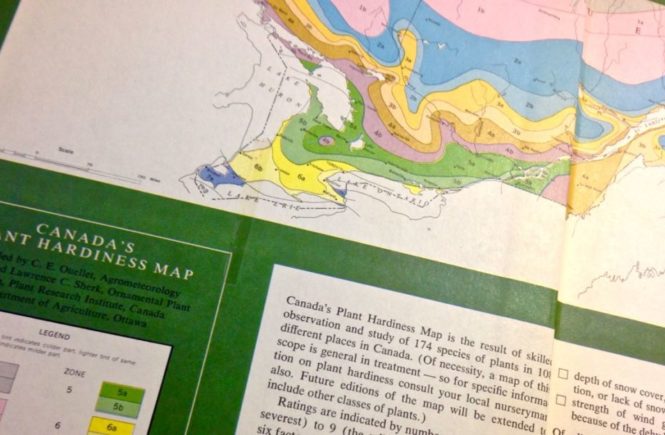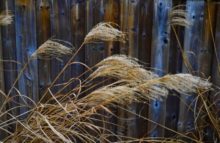Among the Top 10 questions Toronto gardeners ask at Humber Nurseries is one about Canadian hardiness zones. In case you didn’t know: Canada is different from the U.S. Here’s why.
 Both countries map their landscape into zones to denote plant hardiness — where a plant will survive, especially over winter. Yet, Canada and the U.S. use different methods to define them.
Both countries map their landscape into zones to denote plant hardiness — where a plant will survive, especially over winter. Yet, Canada and the U.S. use different methods to define them.
Canada uses a complex formula of seven variables
The product of that formula determines the zone number. Variables include lowest mean temp of the coldest month, highest mean temp of the hottest month, precipitation, number of frost-free days and other factors. Natural Resources Canada explains this all in greater detail at this link [Ed: link updated Feb. 28, 2014]
The U.S. Department of Agriculture or USDA system is simpler
It’s based solely on average annual minimum temperatures. (This mimimum temperature system is followed by most other countries.)
Although Canada considers a larger range of factors than the USDA, we still talk about zones in terms of temperatures: the lower the number, the colder the climate. Both systems also subdivide zones with a letter (a or b). So, Zone 6a is little “colder” than Zone 6b.
In Canadian terms, Toronto is broadly Zone 6; in USDA terms, it’s Zone 5. Our closeness to the Great Lakes moderates temperature highs and lows and increases precipitation.
Within the GTA, the specifics of your landscape can push you higher or lower. Close to Lake Ontario, you’re more likely to be Zone 6b and might have a microclimate (a pocket that is a zone unto itself) that’s Zone 7. In a more exposed situation, or farther from the lake, you might be Canadian Zone 5a or 5b.
Get to know your garden
You might even have a sheltered spot or two where you can cheat and use plants rated for a slightly warmer zone than your area. Or you might have a windy corner that goes the opposite way.
If in doubt, the zone number should be your zone or lower
If you are in Zone 6 and the plant is rated Zone 5 hardy, it will likely work in your garden. If you see Zone 11, drop the plant (gently) and walk away. [I should qualify that: walk away if you hope it will over-winter outdoors in your garden. Many plants that aren’t zone-hardy in Toronto are grown as annuals or brought indoors for the winter, including pelargoniums aka geraniums, coleus, fuschsias and impatiens, to name a few.]
Know who you’re dealing with
Canadian suppliers usually use Canadian zones. International websites or gardening books are likely to use the USDA system.
Remember: Cultural requirements are another thing entirely
You may be able to cheat the zone, but not the food and drink. If your current object of desire asks for moist, fertile, loamy, acid soil in full sun, and you give it dry, sandy, lean soil in deep shade, the only zone you’re living in is the Twilight Zone.





10 comments
haha! You’ve been to Humber! I use to work there long long ago. In fact, it was my very first job where me and my sister started out so thats awesome!
As for Zones, I generally tell people Zone 5 and not zone six because six is not very hardy at all. It’s more towards the niagara region and while we may say we are zone 6, we really only have pockets of zone six while the rest of Toronto (becuas eits a cold wind tunnel at times) is likely zone 5. We try not to carry the Zone six stuff at times, or at least let customers know that they arn’t very hardy beforethey walk out the door and buy. Except in the busy season!
but I liked this post alot. it was fun to read! 😀
Hi, Andrea,
In the GTA, it might be safer to say Zone 5 (USDA Zone 4), but in the downtown area, and in the Beach (upper upper upper, where we are), Zone 6 is pretty much the rule. But, like I say in the post: get to know your garden. Each one is different.
Coincidentally, Sarah once worked at Humber, briefly, too. I’m sure you two (or three) would have stories to tell.
Hi Helen:
Your zone discussion is really excellent. But there is another factor about zone numbers and plants that should be considered when buying plants. Many thrive in colder zones that their published zone. Not that the difference is great (eg. wintering bananas in Winnipeg) but I have adventurous customers who are successfully growing all kinds of plants where the books say wouldn't work. Who when referring to their plants these gardeners sometimes say "I guess they haven't read the books". A favourite saying of mine.
Your point on cultivation is terrific. I learned the under appreciated importance of summer heat from Dan Hinkley. We were discussing Eremurus, a favourite plant of mine when he told that in spite of his milder Oregon climate (zone 9), there wasn't enough summer heat and/or dryness for the roots to ripen. Whereas we have customers growing them in Saskatoon (zone 3)! So while this may complicate things further and confessing my personal bias I think Canadian gardeners have long practiced "zone denial" and should continue to try new plants, bearing the zones and cultivation in mind experiment. Sure we fail sometimes (believe me I know this) but just think of all the successes. Plants we now call easy that 20 years ago were thought risky.
Good cultural advice can help a lot
Dugald, Those are all really excellent points. I know of people outside Toronto (in Zone 4, let's say), who can grow plants that *should* be hardy in Toronto, but aren't, because we don't get reliable snow cover in the city. A consistent, insulating blanket of snow can be a great advantage to plant hardiness, no matter how cold the air temperature above might be.
Why can't we all (USA and Canada, maybe Mexico too) have one unified climate zone map for everyone so that you don't have to wonder if something will grow for you or not. I go by the US zone map myself no matter what some idiot in Canada says because frankly I've done my research and I know that temp x puts me in zone y and zone y correlates to their map's zone 5. I decided to do that for several reasons.The main reason being, all the gardening books I see (with the exception of Cullen's and Hole's books) use the US zone maps. So if the book says its hardy to zone 5 and I know my winter temp for my area I know I'm in zone 5 so everything they say can libve in zone 5 will grow here (more or less) without being winter killed off. but then I go look at a canadian map and it says I'm I dunno lets say zone 4. I'm gonna miss out on growing a lot of hardy plants if I say gee I'm colder then zone 5 I better not grow that because canada says I'm zone 4 never mmind my own thermometer says I'm zone 5. Or worse if its like people hre are saysing and toronto is listed zone 6 ro 7 and I try growing tender stuff. Seriously if I saw zone 7 and Ive read those US books and they say jasmine (technically jasmine nudicaule if I remember right) and gardenias and camellias can grow in zone 7 canada says I'm in zone 7 I'll be buying and trying stuff thats gonna die on me if I truest our maps since thy're wrong for all the data in the US originating books on plants and gardening. I'll be assuming ooh Im in zone 7 (niagra falls) so I can grow jasmine, when in reality I can't because I'm zone 5 or 6. So I say they oughta make the maps uniform internationally to avoid that mess of lying to people saying they can grow stuff they cant outdoors. But thats why I always use US maps for myself and pretend the canadian ones don't existand dont even go by the tags on plants nbecause I know better then to trust our gov whe they label niagra falls zone 7 (and in the USA in zone 7 you can grow jasmine, camellias and gardenias but we definatley cant here no matterwhat our gov says.
Zones are really just meant to be a guide. Canadians, as I said in my post, take other factors into consideration, which is why the number system is different. We just need to get to know our own gardens — in which some areas might even be a zone or two higher or lower than the "actual" zone.
I've grown a few things in North York that are zone 6-7 and haven't had a problem more often than not. I think this also depends on creating your own microclimate by reducing wind exposure with hedges, large trees and fencing. Here's a link to my youtube channel where I'm growing a bunch of different things. https://www.youtube.com/user/MrChip123472
I'm also a regular customer at Humber Nurseries because they carry some interesting things that no one else in the area does.
That's my excuse for trying a single test plant rather than investing in a large swathe. Of course, I don't really need excuses to buy plants.
Commenting two years later, I just want to add that your soil type can also affect plant hardiness. This comes under your point of knowing your own garden. Some plants can tolerate cold but not wet, soggy soil in winter. A lot of Mediterranean plants are like that, so if your hardy lavender doesn't make it through the winter, it may be your heavy, clay soil and not the air temperature that's doing it in.
Very true, Kathy. Thanks for chiming in.